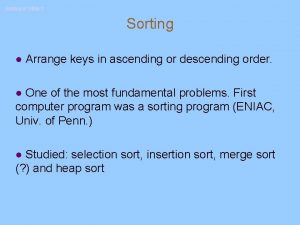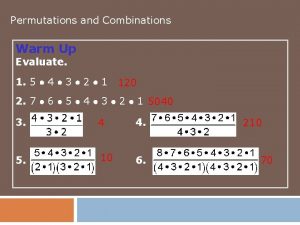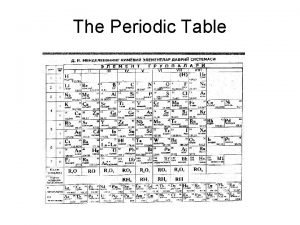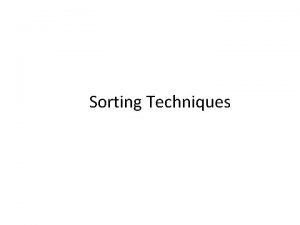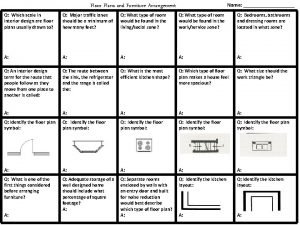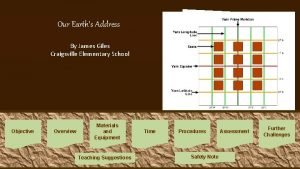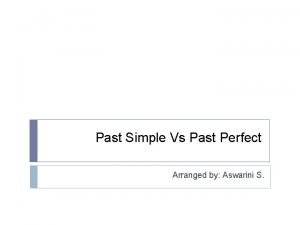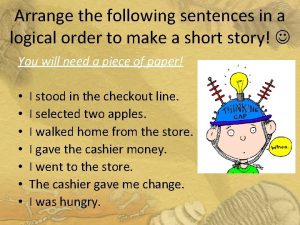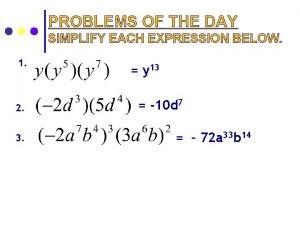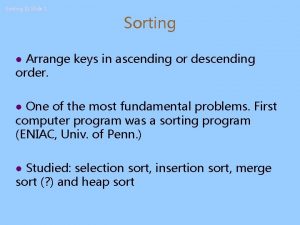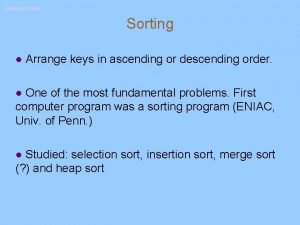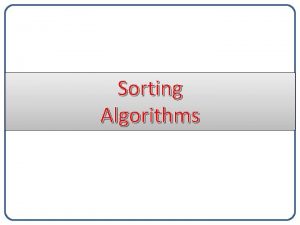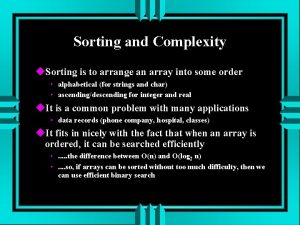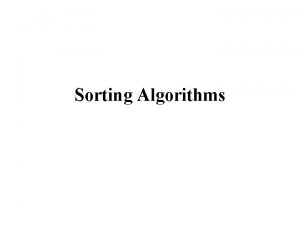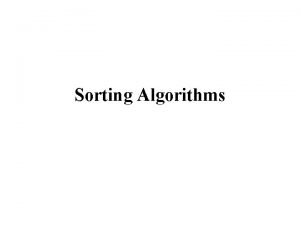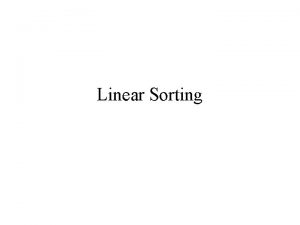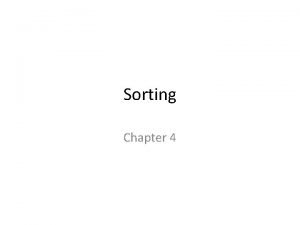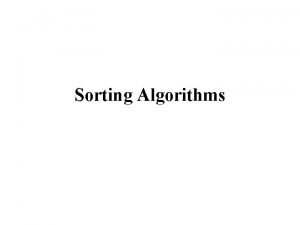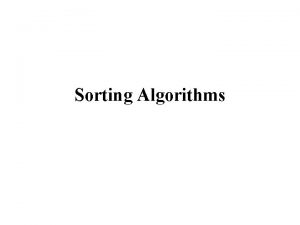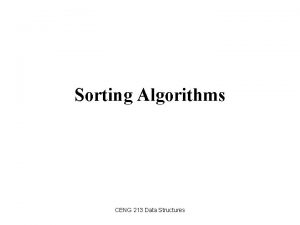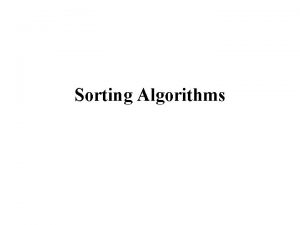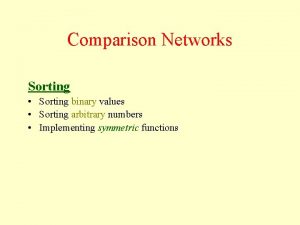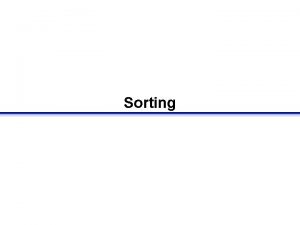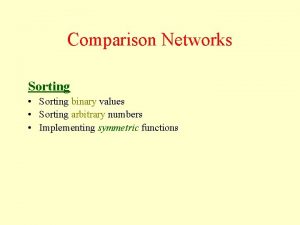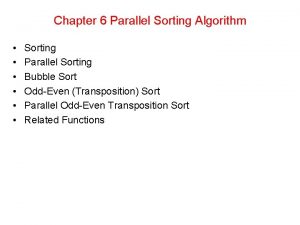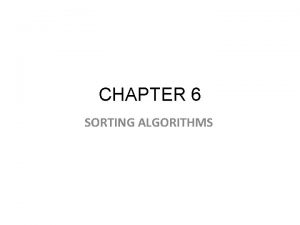Sorting II Slide 1 Sorting l Arrange keys











![Pseudocode Input: an array A[p, r] Quicksort (A, p, r) { if (p < Pseudocode Input: an array A[p, r] Quicksort (A, p, r) { if (p <](https://slidetodoc.com/presentation_image/4c30913db35934302afbec14685d8b28/image-12.jpg)

![Partitioning Strategy § § § Want to partition an array A[left. . right] First, Partitioning Strategy § § § Want to partition an array A[left. . right] First,](https://slidetodoc.com/presentation_image/4c30913db35934302afbec14685d8b28/image-14.jpg)
![Partitioning Strategy § § Want to have § A[p] <= pivot, for p < Partitioning Strategy § § Want to have § A[p] <= pivot, for p <](https://slidetodoc.com/presentation_image/4c30913db35934302afbec14685d8b28/image-15.jpg)

![Partitioning Strategy q When i and j have crossed 5 q Swap A[i] and Partitioning Strategy q When i and j have crossed 5 q Swap A[i] and](https://slidetodoc.com/presentation_image/4c30913db35934302afbec14685d8b28/image-17.jpg)
![Implementation of partitioning step int partition(A, left, right){ int pivot = A[right]; int i Implementation of partitioning step int partition(A, left, right){ int pivot = A[right]; int i](https://slidetodoc.com/presentation_image/4c30913db35934302afbec14685d8b28/image-18.jpg)





![Pivot: median of three A[left] = 2, A[center] = 13, A[right] = 6 2 Pivot: median of three A[left] = 2, A[center] = 13, A[right] = 6 2](https://slidetodoc.com/presentation_image/4c30913db35934302afbec14685d8b28/image-24.jpg)




- Slides: 28

Sorting II/ Slide 1 Sorting l Arrange keys in ascending or descending order. One of the most fundamental problems. First computer program was a sorting program (ENIAC, Univ. of Penn. ) l Studied: selection sort, insertion sort, merge sort (? ) and heap sort l

Sorting II/ Slide 2 Recall two basic sorting algorithms: l selection sorting l insertion sorting We will revisit the applet at: http: //math. hws. edu/TMCM/java/x. Sort. Lab/

Sorting II/ Slide 3 Merge sorting In lecture 2, we studied the merging step. Merging: Take two sorted arrays and combine them into one sorted array. Merge sorting and heap sorting are two algorithms that take O(n log n) time in the worst-case. (best possible)

Sorting II/ Slide 4 Code for merging step void merge( vector<Comparable> & a, vector<Comparable> & tmp. Array, int left. Pos, int right. End ) { int left. End = right. Pos - 1; int tmp. Pos = left. Pos; int num. Elements = right. End - left. Pos + 1; // Main loop while( left. Pos <= left. End && right. Pos <= right. End ) if( a[ left. Pos ] <= a[ right. Pos ] ) tmp. Array[ tmp. Pos++ ] = a[ left. Pos++ ]; else tmp. Array[ tmp. Pos++ ] = a[ right. Pos++ ];

Sorting II/ Slide 5 while( left. Pos <= left. End )// Copy rest of first half tmp. Array[ tmp. Pos++ ] = a[ left. Pos++ ]; while( right. Pos <= right. End )//Copy rest of right half tmp. Array[ tmp. Pos++ ] = a[ right. Pos++ ]; // Copy tmp. Array back for( int i = 0; i < num. Elements; i++, right. End-- ) a[ right. End ] = tmp. Array[ right. End ]; }

Sorting II/ Slide 6 Merge sorting algorithm Recursive version of merge sorting: To sort the array A between indices low and high: if (high == low) return; mid = (low + high) /2; recursively sort A between indices low and mid; recursively sort A between indices mid+1 and high; merge the two sorted halves.

Sorting II/ Slide 7 Merge sorting - Code void merge. Sort( vector<Comparable> & a, vector<Comparable> & tmp. Array, int left, int right ) { if( left < right ) { int center = ( left + right ) / 2; merge. Sort( a, tmp. Array, left, center ); merge. Sort( a, tmp. Array, center + 1, right ); merge( a, tmp. Array, left, center + 1, right ); } }

Quicksort - Introduction § Fastest known sorting algorithm in practice § Average case: O(N log N) § Worst case: O(N 2) § But, the worst case rarely occurs. § Another divide-and-conquer recursive algorithm like mergesort

Quicksort S q Divide step: v q Pick any element (pivot) v in S q Partition S – {v} into two disjoint groups q S 1 = {x S – {v} | x v} q S 2 = {x S – {v} | x v} q Conquer step: recursively sort S 1 and S 2 q Combine step: combine the sorted S 1, followed by v, followed by the sorted S 2 S 1 v S 2

Example: Quicksort

Example: Quicksort. . .
![Pseudocode Input an array Ap r Quicksort A p r if p Pseudocode Input: an array A[p, r] Quicksort (A, p, r) { if (p <](https://slidetodoc.com/presentation_image/4c30913db35934302afbec14685d8b28/image-12.jpg)
Pseudocode Input: an array A[p, r] Quicksort (A, p, r) { if (p < r) { q = Partition (A, p, r) //q is the position of the pivot element Quicksort (A, p, q-1) Quicksort (A, q+1, r) } }

Partitioning § Partitioning Key step of quicksort algorithm § Goal: given the picked pivot, partition the remaining elements into two smaller sets § Many ways to implement § Even the slightest deviations may cause surprisingly bad results. § § § We will learn an easy and efficient partitioning strategy here. How to pick a pivot will be discussed later
![Partitioning Strategy Want to partition an array Aleft right First Partitioning Strategy § § § Want to partition an array A[left. . right] First,](https://slidetodoc.com/presentation_image/4c30913db35934302afbec14685d8b28/image-14.jpg)
Partitioning Strategy § § § Want to partition an array A[left. . right] First, get the pivot element out of the way by swapping it with the last element. (Swap pivot and A[right]) Let i start at the first element and j start at the next-tolast element (i = left, j = right – 1) swap 5 6 4 6 pivot 3 12 19 5 i 6 4 19 3 12 j 6
![Partitioning Strategy Want to have Ap pivot for p Partitioning Strategy § § Want to have § A[p] <= pivot, for p <](https://slidetodoc.com/presentation_image/4c30913db35934302afbec14685d8b28/image-15.jpg)
Partitioning Strategy § § Want to have § A[p] <= pivot, for p < i § A[p] >= pivot, for p > j When i < j § Move i right, skipping over elements smaller than the pivot § Move j left, skipping over elements greater than the pivot § When both i and j have stopped § A[i] >= pivot A[j]19<= 3 pivot 12 6 5 6§ 4 5 6 4 19 3 12 6 i j

Partitioning Strategy q When i and j have stopped and i is to the left of j q Swap A[i] and A[j] q The large element is pushed to the right and the small element is pushed to the left q After swapping q A[i] <= pivot q A[j] >= pivot q Repeat the process until i and j cross swap 5 6 i 4 19 3 12 j 6 5 3 i 4 19 6 12 j 6
![Partitioning Strategy q When i and j have crossed 5 q Swap Ai and Partitioning Strategy q When i and j have crossed 5 q Swap A[i] and](https://slidetodoc.com/presentation_image/4c30913db35934302afbec14685d8b28/image-17.jpg)
Partitioning Strategy q When i and j have crossed 5 q Swap A[i] and pivot q Result: q A[p] <= pivot, for p < i q A[p] >= pivot, for p > i 4 19 6 12 5 3 3 6 j i 5 http: //math. hws. edu/TMCM/java/x. Sort. Lab/ 3 4 19 6 12 j i 4 6 j i 6 6 12 19
![Implementation of partitioning step int partitionA left right int pivot Aright int i Implementation of partitioning step int partition(A, left, right){ int pivot = A[right]; int i](https://slidetodoc.com/presentation_image/4c30913db35934302afbec14685d8b28/image-18.jpg)
Implementation of partitioning step int partition(A, left, right){ int pivot = A[right]; int i = left, j = right-1; for (; ; ) { while (a[i] < pivot && i <= right) i++; while (pivot < a[j] && j >= left) j--; if (i < j) {swap(a[i], a[j]); i++; j--; } else break; } swap(A[i], A[right]); return i; }

Small arrays § For very small arrays, quicksort does not perform as well as insertion sort § § how small depends on many factors, such as the time spent making a recursive call, the compiler, etc Do not use quicksort recursively for small arrays § Instead, use a sorting algorithm that is efficient for small arrays, such as insertion sort

Picking the Pivot § Use the first element as pivot if the input is random, then we can choose the key in position A[right] as pivot. § if the input is sorted (straight or reverse) § all the elements go into S 2 (or S 1) § this happens consistently throughout the recursive calls § Results in O(n 2) behavior (Analyze this case later) § § Choose the pivot randomly generally safe § random number generation can be expensive §

Picking the Pivot q Use the median of the array q Partitioning always cuts the array into roughly half q An optimal quicksort (O(N log N)) q However, hard to find the exact median

Pivot: median of three We will use median of three § Compare just three elements: the leftmost, rightmost and center § Swap these elements if necessary so that § A[left] = Smallest § A[right] = Largest median 3 § A[center] = Median of three § Pick A[center] as the pivot § Swap A[center] and A[right – 1] so that pivot is at second last position (why? ) §

Sorting II/ Slide 23 Pivot: median of three Code for partitioning with median of three pivot:
![Pivot median of three Aleft 2 Acenter 13 Aright 6 2 Pivot: median of three A[left] = 2, A[center] = 13, A[right] = 6 2](https://slidetodoc.com/presentation_image/4c30913db35934302afbec14685d8b28/image-24.jpg)
Pivot: median of three A[left] = 2, A[center] = 13, A[right] = 6 2 5 6 4 13 3 12 19 2 5 6 4 6 3 12 19 13 Swap A[center] and A[right] 2 5 6 4 6 3 12 19 13 Choose A[center] as pivot 6 pivot 2 5 6 4 19 3 12 6 13 Swap pivot and A[right – 1] pivot Note we only need to partition A[left + 1, …, right – 2]. Why?

Sorting II/ Slide 25 Implementation of partitioning step § Works only if pivot is picked as median-of-three. § A[left] <= pivot and A[right] >= pivot § Thus, only need to partition A[left + 1, …, right – 2] § j will not run past the end § because a[left] <= pivot § i will not run past the end § because a[right-1] = pivot

Main Quicksort Routine Choose pivot Partitioning Recursion For small arrays

Quicksort Faster than Mergesort § Both quicksort and mergesort take O(N log N) in the average case. § Why is quicksort faster than mergesort? § The inner loop consists of an increment/decrement (by 1, which is fast), a test and a jump. § Mergesort involves a large number of data movements. § Quicksort is done in-place.

Performance of quicksort § § Worst-case: takes O(n 2) time. Average-case: takes O(n log n) time. On typical inputs, quicksort runs faster than other algorithms. Compare various sorting algorithms at: http: //www. geocities. com/siliconvalley/network/1854/ Sort 1. html
 Keys to content writing
Keys to content writing Priesthood keys the restoration of priesthood keys
Priesthood keys the restoration of priesthood keys Heel and toe step
Heel and toe step Internal sorting and external sorting
Internal sorting and external sorting Factoring checklist
Factoring checklist L'arrange
L'arrange Increasing atomic size
Increasing atomic size Create a food chain of the following organisms
Create a food chain of the following organisms Example of permutation
Example of permutation Arranging sentences into paragraph
Arranging sentences into paragraph How to arrange elements in increasing atomic size
How to arrange elements in increasing atomic size Clear 3. hali
Clear 3. hali Specifies the way to arrange data in a particular order
Specifies the way to arrange data in a particular order Star colors from coolest to hottest
Star colors from coolest to hottest Floor plan arrangement
Floor plan arrangement Arrange into groups
Arrange into groups Arrange past
Arrange past Arrange the following sentences in correct order
Arrange the following sentences in correct order Promoting services and educating customers
Promoting services and educating customers Arrange for sb to do
Arrange for sb to do Le temps arrange tout
Le temps arrange tout Benefits of arranged marriage
Benefits of arranged marriage How did mendeleev arrange the elements? *
How did mendeleev arrange the elements? * Arrange words
Arrange words Arrange earth's layers from coolest to hottest
Arrange earth's layers from coolest to hottest Number and alphabet test
Number and alphabet test Fungsi kantor to arrange information adalah
Fungsi kantor to arrange information adalah Arrange the sentences in the correct order
Arrange the sentences in the correct order Simplify the expression below
Simplify the expression below





